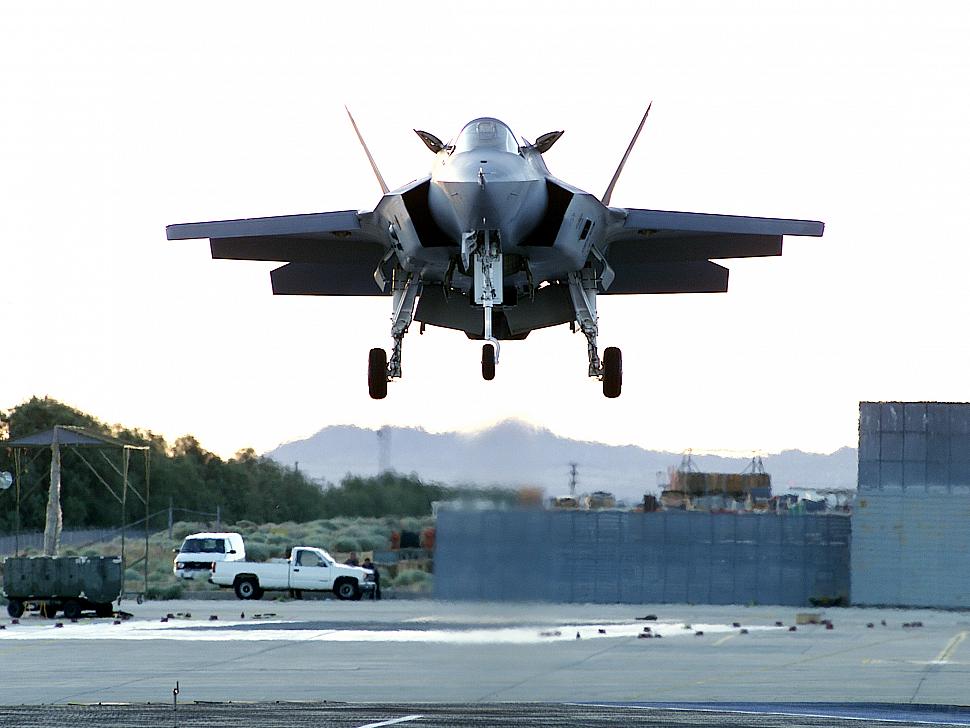Fighter Jet News
F-35 Lightning II News
F-35 weight issues resolved, focus is now on production
September 14, 2004 (by
Lieven Dewitte) -
Engineers have removed more than 2,700 pounds (1,225 kilograms) of unwanted estimated weight from the short-takeoff/vertical-landing (STOVL) version of the F-35 JointStrike Fighter, while increasing propulsion efficiency and reducing drag.

The result is an F-35 JSF design recommendation that is expected to meet or exceedall of its performance requirements.
"The F-35 is now tracking ahead of its Key Performance Parameters, andpast concerns about the aircraft's aerodynamic performance have diminished,"said Tom Burbage, Lockheed Martin executive vice president andgeneral manager of F-35 JSF program integration. "Because of the designsimilarities among the three F-35 variants, many of the STOVL-versionrefinements will translate to the conventional and carrier versions, whichalready met their performance requirements even before the STOVL improvementswere instituted."
The F-35 team anticipates final approval of the STOVL revisions when theU.S. Defense Acquisition Board meets on Oct. 14.
"We have addressed every known aspect affecting STOVL aerodynamic performance and shipboard compatibility," said Rear Adm. Steven Enewold, F-35JSF program executive director. "We feel our proposed configuration isoperationally viable. The next step is to get the trade-study resultsimplemented into the detailed STOVL design package."
With first flight expected in August 2006, production becomes theprogram's central focus. All four of the first test aircraft's major subassemblies are now in work. Last month BAE SYSTEMS began assembling the aft fuselage and tails in Samlesbury, England, and Lockheed Martin started wing assembly at the company's Fort Worth plant. In May, Northrop Grumman kicked off F-35 assembly when it began making the center fuselage in Palmdale, Calif. Forward-fuselage assembly started the following month in Fort Worth.Production of control surfaces and edges will soon be under way at Lockheed Martin's Palmdale site.
Final assembly of the F-35 is planned to start next spring in Fort Worth, with completion of the first aircraft anticipated in late 2005.
The program already is preparing for the challenge of operating, supporting and sustaining thousands of F-35s worldwide. Nine countries currently are engaged in the aircraft's development and are expected to begin adding F-35s to their fleets early in the next decade. Many other nations have expressed interest in the aircraft, and the roster of international F-35 customers is likely to grow. The task of sustaining such a large number of aircraft over a geographically dispersed area for more than 40 years will be made possible by the F-35's exceptional reliability, its next-generation onboard diagnostics, its standardized and simplified maintenance processes, streamlined supply-chain management and many other advances over current fighters.

Following a vertical take off, the X-35B holds a stationary position 25 feet above the ground at Lockheeds Palmsdale plant on June 24th 2001. Pilot Simon Hargreaves described the flight as a stunning success. [LMTAS photo]
"The F-35 is now tracking ahead of its Key Performance Parameters, andpast concerns about the aircraft's aerodynamic performance have diminished,"said Tom Burbage, Lockheed Martin executive vice president andgeneral manager of F-35 JSF program integration. "Because of the designsimilarities among the three F-35 variants, many of the STOVL-versionrefinements will translate to the conventional and carrier versions, whichalready met their performance requirements even before the STOVL improvementswere instituted."
The F-35 team anticipates final approval of the STOVL revisions when theU.S. Defense Acquisition Board meets on Oct. 14.
"We have addressed every known aspect affecting STOVL aerodynamic performance and shipboard compatibility," said Rear Adm. Steven Enewold, F-35JSF program executive director. "We feel our proposed configuration isoperationally viable. The next step is to get the trade-study resultsimplemented into the detailed STOVL design package."
With first flight expected in August 2006, production becomes theprogram's central focus. All four of the first test aircraft's major subassemblies are now in work. Last month BAE SYSTEMS began assembling the aft fuselage and tails in Samlesbury, England, and Lockheed Martin started wing assembly at the company's Fort Worth plant. In May, Northrop Grumman kicked off F-35 assembly when it began making the center fuselage in Palmdale, Calif. Forward-fuselage assembly started the following month in Fort Worth.Production of control surfaces and edges will soon be under way at Lockheed Martin's Palmdale site.
Final assembly of the F-35 is planned to start next spring in Fort Worth, with completion of the first aircraft anticipated in late 2005.
The program already is preparing for the challenge of operating, supporting and sustaining thousands of F-35s worldwide. Nine countries currently are engaged in the aircraft's development and are expected to begin adding F-35s to their fleets early in the next decade. Many other nations have expressed interest in the aircraft, and the roster of international F-35 customers is likely to grow. The task of sustaining such a large number of aircraft over a geographically dispersed area for more than 40 years will be made possible by the F-35's exceptional reliability, its next-generation onboard diagnostics, its standardized and simplified maintenance processes, streamlined supply-chain management and many other advances over current fighters.
Related articles:
Tags
Tags
